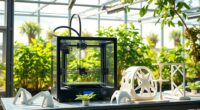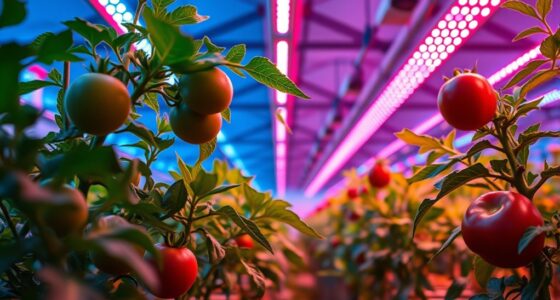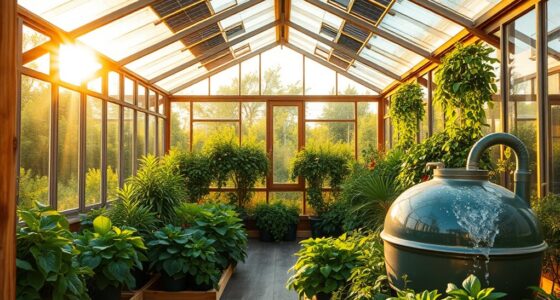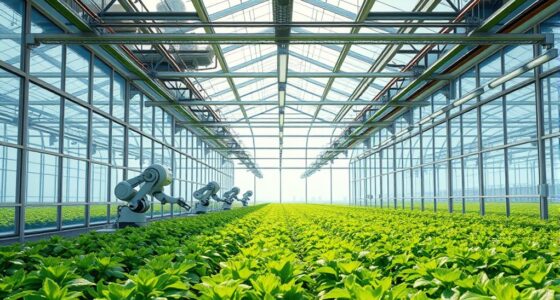Controlled environment agriculture, or indoor farming, uses advanced technologies to grow crops efficiently year-round. You can implement hydroponic systems that deliver nutrients directly to plants, saving water and boosting yields. Automated climate control systems adjust temperature, humidity, and light, creating perfect growing conditions while reducing energy use. Real-time monitoring helps catch problems early and optimize growth. If you keep exploring, you’ll discover how these innovations are transforming food production for a sustainable future.
Key Takeaways
- Utilizes automated climate control systems to maintain optimal temperature, humidity, and light conditions for plant growth.
- Employs hydroponic and nutrient delivery systems for efficient, soil-less cultivation and faster yields.
- Integrates real-time sensors for monitoring environmental parameters and crop health.
- Uses scalable, modular setups suitable for urban farms and vertical gardens.
- Promotes sustainability by conserving water, reducing chemical use, and minimizing transportation emissions.
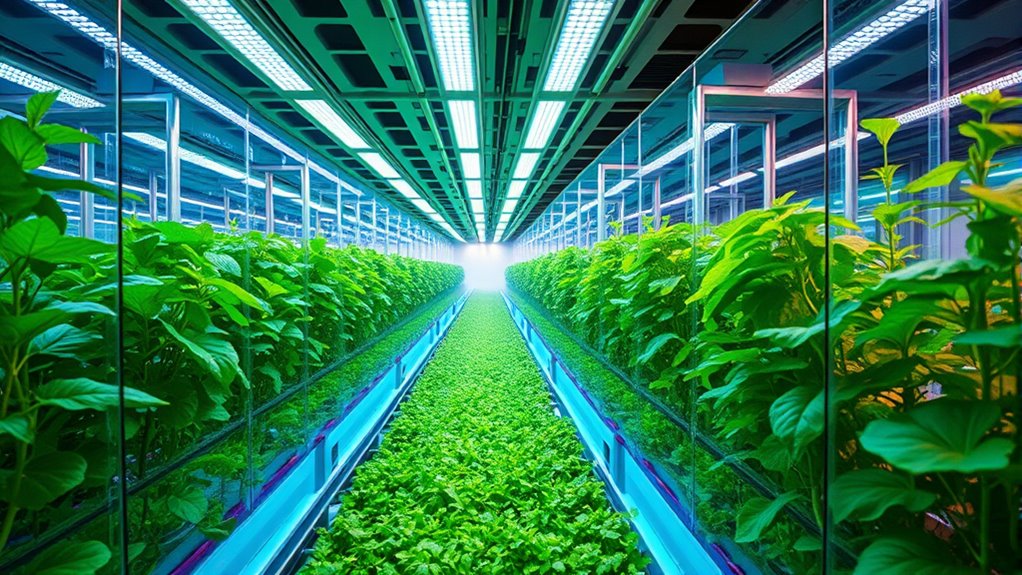
Have you ever wondered how indoor farming technology is transforming the way we grow food? The answer lies in innovative systems that optimize plant growth in controlled environments. These advancements make it possible to produce fresh produce year-round, regardless of outdoor weather conditions. At the heart of this revolution are hydroponic systems and automated climate control, which work together to create ideal growing conditions while optimizing resource use.
Hydroponic systems are a game-changer for indoor farming. Instead of soil, plants grow in nutrient-rich water solutions, which allows for faster growth and higher yields in a smaller space. With hydroponics, you can precisely control the delivery of nutrients directly to the roots, reducing waste and ensuring plants get exactly what they need. This method not only accelerates growth rates but also minimizes soil-borne pests and diseases, reducing the need for chemical interventions. Hydroponic setups are modular, scalable, and adaptable to different crops, making them perfect for urban farms, vertical gardens, and large commercial operations alike. They also use *considerably* less water than traditional soil-based farming, as water is recirculated through the system, lowering overall consumption and environmental impact. Additionally, advancements in monitoring technology enable real-time data collection, further optimizing growth conditions. Implementing sensor networks can help detect issues early and improve overall system efficiency. Developing efficient nutrient delivery systems can further enhance plant health and growth efficiency in these setups. Incorporating automated watering systems can also improve consistency and reduce labor costs, making indoor farming more sustainable.
Alongside hydroponic systems, automated climate control plays a *vital* role in indoor farming. This technology involves sensors and advanced software that monitor temperature, humidity, light levels, and airflow in real time. As conditions fluctuate, automated systems adjust heating, cooling, ventilation, and lighting to maintain *ideal* growing environments. Imagine never having to manually tweak a thermostat or open a window—these systems do it for you, ensuring plants stay in their perfect comfort zone. This precise control reduces stress on plants, promotes healthy growth, and yields consistent results. Automated climate control also helps conserve energy by optimizing equipment operation, which can *considerably* lower operational costs. *Moreover*, it enables farms to adapt quickly to changing external conditions, such as heatwaves or cold snaps, ensuring crops always receive the *perfect* environment for growth. Understanding the refrigeration cycle is essential for maintaining the efficiency of climate control systems, ensuring they operate reliably and sustainably.
Together, hydroponic systems and automated climate control empower indoor farmers to maximize productivity and sustainability. They make it possible to grow diverse crops in confined spaces, with minimal resource use and reduced environmental footprint. You can produce fresh, nutritious food close to urban centers, reducing transportation emissions and supply chain vulnerabilities. This synergy of technology not only boosts efficiency but also opens new avenues for innovation in agriculture, providing a scalable, eco-friendly way to meet the growing global demand for food. As indoor farming continues to evolve, these tools will remain essential in shaping the future of how we cultivate and consume our food.
Frequently Asked Questions
What Are the Initial Costs of Setting up Indoor Farms?
When considering the initial costs of setting up indoor farms, you should do a thorough cost analysis to understand all investment costs involved. These costs typically include equipment, lighting, climate control systems, and infrastructure. You’ll need to budget for high-quality LED lights, HVAC systems, and sensors. While the upfront investment might seem steep, it often pays off with increased yields and efficiency. Planning carefully helps you manage expenses effectively from the start.
How Energy-Efficient Are Indoor Farming Systems?
Indoor farming systems can be quite energy-efficient if you optimize lighting efficiency and incorporate renewable energy sources. By using LED lighting and smart automation, you reduce electricity consumption, making your setup more sustainable. Switching to renewable energy like solar or wind further lowers energy costs and carbon footprint. Overall, with these strategies, indoor farms can operate efficiently, conserving energy while maximizing crop yield and quality.
What Crops Are Best Suited for Indoor Cultivation?
Choosing the right crops is like planting seeds of hope—you want the best for your indoor farm. You should focus on crop selection and plant varieties that thrive in controlled environments, such as leafy greens, herbs, and strawberries. These crops adapt well to indoor cultivation, offering quick yields and high quality. By selecting the right plants, you turn your indoor space into a bountiful oasis, maximizing productivity and sustainability.
How Does Indoor Farming Impact Local Food Security?
Indoor farming boosts your urban food supply by providing fresh, local produce year-round. It reduces reliance on distant sources, strengthening your community’s food security and shortening the supply chain. By growing food indoors, you can better withstand disruptions like weather or transportation issues. This means you get dependable access to healthy, sustainable options, making your local food system more resilient and self-sufficient.
What Are the Future Trends in Indoor Farming Technology?
Did you know indoor farming is projected to grow by 12% annually? You’ll see future trends focus on sustainable practices and automation innovations, making farms more efficient and eco-friendly. Expect smarter climate control systems, AI-driven monitoring, and robotic harvesting to reduce labor costs and resource use. These advancements will help you produce higher yields with less environmental impact, transforming indoor farming into a sustainable, high-tech solution for global food security.
Conclusion
As you explore controlled environment agriculture, remember that “the early bird catches the worm.” With innovative indoor farming tech, you can grow fresh produce year-round, no matter the weather outside. By mastering these systems, you’re planting the seeds for a more sustainable future. Embrace the challenge, and watch your efforts bloom into lush, abundant harvests—proof that with the right environment, anything is possible.

